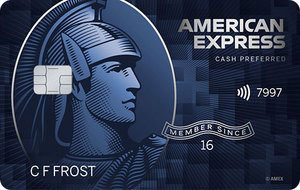Grocery shopping is a great equalizer. Rich and poor, adventurous cooks and microwave-only eaters — pretty much everyone knows what it’s like to browse supermarket shelves. By now, most know how to play the grocery delivery game too.
So it’s no surprise that supermarket credit card offers are so popular up and down the income scale.
From entry-level spending aids like the Blue Cash Everyday Card from American Express to prime products like the Amazon Prime Rewards Visa Signature Card, there’s almost certainly a rewards card tailored to your grocery shopping habits and credit score.
Best Credit Cards for Groceries
These are among the best grocery credit cards to use for grocery store and supermarket purchases. Each one does at least one thing really well, whether it’s delivering unlimited cash back at impressive rates or offering unique value-adds users can’t find anywhere else.
Just be aware that unless otherwise noted, these credit cards exclude grocery purchases made at superstores like Walmart, Target, and Meijer and warehouse clubs (wholesale clubs) like Sam’s Club and Costco from their supermarket rewards categories.
Blue Cash Preferred® Card From American Express

The Blue Cash Preferred® card from American Express rewards U.S. supermarket purchases better than any major credit card on the market: 6% cash back on the first $6,000 in annual purchases (then 1%).
That’s up to $360 in supermarket cash back, or $265 after accounting for the $95 annual fee, though you don’t pay the annual fee the first year (see rates and fees).
Cash back accrues as Reward Dollars you can redeem for statement credits or Amazon.com checkout.
It’s a solid haul by any stretch — one most multiperson households can easily achieve.
- Welcome Offer: Earn $250 back after you spend at least $3,000 on purchases within the first 6 months. Cash back accrues as Reward Dollars that can be redeemed for statement credits.
- Earning Rewards: In addition to 6% cash back on the first $6,000 annually at U.S. supermarkets, you can earn earn 6% cash back on U.S. streaming services, including Amazon Prime, Netflix, HBO, Audible, and Apple Music. Plus, earn 3% cash back on two other bonus categories: U.S. gas station and local transportation and transit purchases, including parking, tolls, and ridesharing fares. All other eligible purchases earn 1% cash back.
- Redeeming Rewards: Cash back accrues as Reward Dollars that can be redeemed for statement credits or at Amazon.com checkout.
- Introductory APR: 0% APR on purchases for the first 12 months your Blue Cash Preferred Card account is open — after that, regular variable APR applies (currently 19.24% to 29.99%). The balance transfer APR is a variable 19.24% to 29.99% from day one.
- Annual Fee: $0 Intro annual fee in year one, then $95
Pros
- Well above-average return on U.S. supermarket spending
- Multiple additional 6% and 3% bonus cash-back categories
- Above-average purchase APR promotion
Cons
- Has an annual fee after the first year
- Has a foreign transaction fee
For rates and fees of the Blue Cash Preferred® Card From American Express, see the rates and fees page.
Capital One SavorOne Cash Rewards Credit Card

The Capital One SavorOne Cash Rewards credit card earns unlimited 3% cash back on supermarket purchases.
With no cap on rewards in this category, SavorOne is ideal if you have a big annual grocery budget — above $6,000. And with multiple bonus cash-back categories, it’s a strong everyday spending credit card too.
- Sign-up Bonus: Earn a one-time $200 cash bonus after you spend $500 on purchases within the first 3 months from account opening
- Earning Rewards: On top of 3% back on grocery purchases, earn 10% back on Uber and UberEats purchases, unlimited 5% back on eligible hotel and car rental bookings through Capital One Travel, unlimited 3% back on dining and entertainment (including streaming) purchases, and 1% back on all other eligible purchases.
- Redeeming Rewards: Redeem for statement credits or bank account deposits in any amount.
- Introductory APR: Enjoy 0% APR on purchases and balance transfers for the first 15 months from your account opening date. After that, variable regular APR applies (currently 19.99% to 29.99%).
- Annual Fee: $0
Pros
- Above-average early spend bonus
- Multiple bonus cash-back categories (up to 10% back on select purchases)
- No annual fee
Cons
- Low baseline cash-back rate
- High regular APR
Capital One SavorOne Student Cash Rewards Credit Card

Like its parent card, the Capital One SavorOne Student Cash Rewards Credit Card earns unlimited 3% cash back on eligible grocery store purchases, excluding purchases at superstores like Walmart and Target.
That makes it the perfect card for two- or four-year degree students living on their own or with roommates and managing their own grocery bills as part of their newfound independence. It’s also great first credit card in general thanks to Capital One’s commitment to consider cardholders for higher credit lines after as few as six months of responsible use.
- Sign-up Bonus: Earn $50 when you spend $100 in the first 3 months.
- Earning Rewards: Earn 10% back on Uber and Uber Eats purchases, 5% back on Capital One Travel purchases, 3% back on dining and entertainment purchases (including streaming), and 1% back on everything else.
- Redeeming Rewards: Redeem in any amount for statement credits or bank account deposits.
- Introductory APR: None
- Annual Fee: $0
Pros
- Up to 10% back on eligible purchases
- Multiple 3% cash-back categories
- No annual fee
Cons
- No 0% intro APR offer
- Low baseline cash-back rate
- High regular APR
American Express® Gold Card

The American Express® Gold card earns 4 Membership Rewards points per $1 spent on the first $25,000 in U.S. supermarket purchases each year. That’s up to 100,000 bonus points on annual supermarket spending, worth up to $0.01 per point at redemption — a 4% return on spending.
Above the annual spending cap, you earn 1 point per $1 spent on U.S. supermarket purchases. But unless you have a huge grocery budget, you don’t need to worry about running over.
- Welcome Offer: Earn 60,000 Membership Rewards points after you spend $6,000 on eligible purchases with your new card within the first 6 months of card membership.
- Earning Rewards: In addition to 4x points on eligible U.S. supermarket purchases (up to $25,000 spent per calendar year, then 1x), earn 4x points on eligible restaurant purchases (including takeout and delivery in the U.S.). Earn 3x points on airfare purchased directly with the airline and at amextravel.com, and 1x point on all other eligible purchases.
- Redeeming Rewards: Redeem for travel bookings, gift cards, Uber rides, general merchandise, and statement credits at the American Express membership rewards portal. Redemption minimums begin at 1,000 points.
- Additional Benefits: Get up to $10 in dining statement credits per month (up to $120 per year) with select participating chains and apps, including Grubhub (enrollment is required and terms apply). Plus, get up to $10 in Uber Cash per month (up to $120 per year) when you add your Gold Card as a payment method in the app (enrollment is required and terms apply).
- Annual Fee: $250
Pros
- 4x points on eligible restaurant purchases
- 3x points on eligible airfare purchases booked directly with the airlines or on amextravel.com
- Above-average welcome offer with longer-than-average qualifying period
Cons
- High annual fee
- Low baseline rewards rate
For specific rates and fees of the American Express® Gold card, see its rates and fees page.
Prime Visa

The Prime Visa Card is the obvious choice for Amazon Prime members who do most or all their grocery shopping through Amazon Fresh, or Whole Foods Market. All Amazon-ecosystem purchases, including both perishable and nonperishable groceries, earn 5% cash back.
It’s easy to redeem your Amazon cash-back rewards in any amount for purchase credits at checkout, making this a truly seamless grocery rewards credit card for Amazon fans.
- Sign-up Bonus: For a limited time, get a $100 Amazon gift card instantly upon approval. If you're not an Amazon Prime member, you'll still qualify for a $50 Amazon gift card at approval.
- Earning Rewards: In addition to 5% back on Whole Foods purchases, earn 5% back on eligible Amazon.com purchases, including groceries. Earn unlimited 2% cash back on purchases made at restaurants, gas stations, and drugstores, and 1% back on all other eligible purchases.
- Bonus Rewards: Earn up to 10% bonus rewards on a rotating selection of Amazon.com merchandise.
- Redeeming Rewards: Redeem in any amount for cash back via credits against Amazon purchases, general statement credit, or bank account deposits.
- Annual Fee: $139 for Amazon Prime
Pros
- Multiple 2% cash-back categories
- No foreign transaction fee
- Up to 10% bonus rewards on eligible Amazon purchases
Cons
- Requires Prime membership ($139 per year)
- Low baseline cash-back rate
- No 0% intro APR offer
Blue Cash Everyday® Card From American Express

Delivering 3% cash back on the first $6,000 per category in purchases made at U.S. supermarkets and U.S. gas stations each year and 1% cash back on U.S. supermarket and U.S. gas station purchases thereafter, it’s ideal for moderate spenders who don’t need outsize grocery-shopping firepower. That’s still $180 in bonus cash back on top of the baseline cash rate.
- Welcome Offer: Earn a $200 statement credit after you spend $2,000 in purchases on your new card within the first 6 months.
- Earning Rewards: In addition to 3% back on U.S. supermarket and U.S. gas station purchases (up to $6,000 in yearly purchases in each category, then 1%), earn 3% cash back on U.S. online retail purchases (up to $6,000 per year, then 1%) and 1% back on all other eligible purchases.
- Redeeming Rewards: Cash back accrues as Reward Dollars that can be redeemed for statement credits or at Amazon.com checkout.
- Introductory APR: 0% intro APR on purchases for 15 months from your account opening date, then regular variable APR applies (currently 19.24% - 29.99%). The balance transfer APR is a variable 19.24% - 29.99% from day one.
- Annual Fee: $0
Pros
- Multiple 3% cash-back categories
- Above-average welcome offer
- No annual fee
- 0% intro APR on purchases
Cons
- Low baseline cash-back rate
- No 0% intro balance transfer APR
For rates and fees of the Blue Cash Everyday® Card from American Express, see the rates and fees page.
Citi Double Cash® Card

The Citi Double Cash® card earns 2% cash back on all eligible purchases, including purchases at the supermarket. If you’re not interested in carrying a separate card solely for supermarket transactions, this is as good a choice as any — the best flat-rate cash-back card for grocery shopping, in fact.
Just be sure to pay your entire balance in full each month, as you only earn the full 2% cash-back allowance when you zero-out your statement.
- Sign-up Bonus: None
- Earning Rewards: Earn up to 2% cash back: 1% when you make the purchase and another 1% when you pay your bill. Pay in full to earn unlimited 2% cash back on all eligible purchases, including grocery store purchases.
- Redeeming Rewards: Redeem for statement credits, gift cards, and more, starting at $25.
- Introductory APR: 0% APR on balance transfers for 18 months from your account opening date — after that, regular variable APR applies (currently 18.99% to 28.99%. The purchase APR is 18.99% to 28.99% from the beginning.
- Annual Fee: $0
Pros
- No limits on 2% cash back when you pay in full
- No annual fee
- Long 0% intro APR balance transfer promotion
Cons
- No intro purchase APR
- Has a 3% foreign transaction fee
- No sign-up bonus
Methodology: How We Choose the Best Grocery Credit Cards
We use several important factors to assess supermarket credit cards and present the very best to our readers.
These include factors related to the credit cards’ rewards and return on spending, value-added benefits, cost, versatility, and overall usability.
Supermarket Rewards
When it comes to this all-important category, we’re looking at the type of rewards earned by supermarket spending, the rate at which that spending earns rewards, and the overall value of those rewards. The best cards earn supermarket rewards at high rates via a versatile loyalty currency — preferably cash back or high-value travel rewards.
Caps & Restrictions on Supermarket Rewards
Unrestricted is better, but we recognize that credit card issuers have to cut their losses. Still, we try to avoid credit cards with tight caps on grocery store reward earnings or other restrictions that limit user value.
Other Rewards
Most grocery store credit cards earn bonus points or cash back on other purchases as well. We prefer cards with multiple nongrocery bonus categories — the higher the earning rate, the better.
Welcome Offer (Sign-Up Bonus)
Most of the credit cards on this list have generous sign-up bonuses (also known as welcome offers or early spend bonuses) for new cardholders. These offers come and go, so their presence isn’t required, but the more generous offers tend to get higher billing.
0% APR Offer
Some of the cards on this list also have nice 0% APR introductory offers for purchases or balance transfers. If you’re planning a big purchase — perhaps an unusually large trip to the grocery store — or need to pay down high-interest credit card debt, these offers can save you a ton of interest.
Annual Fee
No credit card user likes paying an annual fee. That said, sometimes, you have to spend money to make money. And some of the most generous supermarket credit cards charge annual fees.
We prefer credit cards without annual fees, though, so we’ve done our best to weed out the substandard ones.
Grocery Store Credit Card FAQs
Still have questions about the best credit cards to use at the supermarket? Find answers to some of the most common queries about this credit card category.
Do Rotating-Category Credit Cards Earn Rewards at the Supermarket?
It’s worth calling out the sometimes-supermarket credit cards that didn’t make this list. It’s not that they’re never worth using at the grocery store. Rather, they only perform from time to time.
Take the Chase Freedom Flex Credit Card, for instance. Freedom reliably earns 5% cash back on grocery store purchases for one quarter per year, up to $1,500 in quarterly category spending. The catch: Grocery store earnings drop to just 1% the other nine months of the year, supplanted by another favored category.
Cards like Chase Freedom Flex are fine for cardholders who can adjust their spending as the opportunity arises. Those who sideline their primary grocery card during Chase Freedom’s bonanza quarter can earn impressive average rates of return on grocery store spending throughout the year. But it’s also understandable if you don’t want to juggle two supermarket credit cards.
Do the Best Grocery Credit Cards Charge an Annual Fee?
Not all of them. In fact, the majority of the cards on this list don’t charge annual fees. It’s possible to earn an impressive rate of return on supermarket spending without paying annually for the privilege.
Of course, annual-fee cards tend to be more generous overall. If you like luxe travel and shopping perks, you’ll probably find yourself gravitating toward these premium products.
Do Supermarket Credit Cards Work at Walmart & Target?
If the card has a Visa, Mastercard, or American Express logo, it should physically work at superstores like Walmart and Target.
The catch is that it probably won’t earn bonus points or cash-back dollars. That’s because most supermarket credit cards specifically exclude superstore grocery purchases from bonus eligibility. You might still earn base rewards — typically no more than 1 point per $1 spent — but nothing more.
Can You Link Your Supermarket Credit Card & Store Loyalty Account?
Usually not. You still have to scan your physical store loyalty card or give your phone number at the register to take advantage of member-only pricing or rewards.
The good news is your store loyalty membership status won’t impact your supermarket credit card earnings. You can double dip on store discounts and credit card rewards, also known as stacking.
Final Word
There’s something for everyone on this list. If you’re feeling overwhelmed, take a step back and consider what you’re really looking for in your supermarket credit card.
Ask yourself:
- Whether you’d prefer to avoid paying an annual fee
- Which other spending categories you’d like to earn rewards in
- Your annual grocery budget — some cards cap rewards at specific annual spending thresholds
- Whether you want a sign-up bonus or 0% APR introductory promotion
- How loyal you are to specific supermarket chains, like Whole Foods
Answer each of these questions and you should be left with just a few options. Consider each in turn and choose the one with the best mix of features and rewards for your needs.